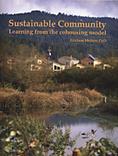urban growth strategic planning scenarios urban renewal simulation safety & security revelation demography anthropology waterfronts & harbors fabrication ricerca urban theory planning technology habitability public policies superplaces scali ferroviari urban development mobility immigration ecology agriculture outskirts & suburbs
Sustainable Community Learning from the cohousing model
Graham Meltzer PhD
This book explores the link between "sustainability" and "community". It is based on a 10 year study of cohousing, a popular new type of planned residential community that pressing environmental and social needs. It used data (including 120 photographs, 50 diagrams and 30 tables) from twelve cohousing developments in Canada, the US, New Zealand, Australia and Japan - concrete examples of successful sustainable comunities.
The book is scholarly and authoritative, yet accessible to a broad intelligent readership as an illustrated account of a fashinating cultural phenomenon. It will be valued to students of architecture, planning, sociology, community psychology and environmental studies as well as architects, planners and other professionals. It should prompt local authorities and developers to envisage and implement genuinely sustainable urban development proposals.
Sustainable Community - Learning from the cohousing model in depht and insightful information for partecipants in the cohousing, ecovillages, sustainability and communities movements. It is well known that such activists face a scarcity of literature from which to draw ideas and inspiration. This book will help fill that avoid.
"If this book encourages more people to explore innovative ways of sharing living space, it will have made a real contribution to a better future." Professor Ian Lowe AO
Dr Graham Metzer is considered the world's leading expert on cohousing. He is an architect, scholar and commercial photographer who consults, research and lectures in environmental and social architecture, housing and communalism.
CONTENTS
PART ONE
Chapter 1 Introduction
Chapter 2 Quayside Village Cohousing
Chapter 3 WindSong Cohousing
Chapter 4 Songaia Cohousing
Chapter 5 Puget Ridge Cohousing
Chapter 6 Marsh Commons Cohousing
Chapter 7 N Street Cohousing
Chapter 8 Berkeley Cohousing
Chapter 9 Swan’s Market Cohousing
Chapter 10 Earthsong Eco-Neighbourhood
Chapter 11 Cohousing Cooperative
Chapter 12 Cascade Cohousing
Chapter 13 Kyõdõ no mori Cohousing
PART TWO
Chapter 14 Circumstance: physical setting and managed systems
Chapter 15 Interaction: interpersonal influence and exchange
Chapter 16 Relationship: close sharing and social support
Chapter 17 Engagement: from belonging to efficacy
Chapter 18 Empowerment: lessons from the cohousing model
Chapter 19 Sustainable Community: applying the lessons
List of Tables
Table 2.1: Community Data, Quayside Village Cohousing
Table 3.1: Community Data, WindSong Cohousing
Table 4.1: Community Data, Songaia Cohousing
Table 4.2: Songaia’s ten-year development journey
Table 5.1: Community Data, Puget Ridge Cohousing
Table 6.1: Community Data, Marsh Commons
Table 7.1: Community Data, N Street Cohousing
Table 8.1: Community Data, Berkeley Cohousing
Table 9.1: Community Data, Swan’s Market Cohousing
Table 10.1: Community Data, Earthsong Eco-Neighbourhood
Table 10.2: Projected average household cost savings, Earthsong
Eco-Neighbourhood
Table 11.1: Community Data, Cohousing Cooperative
Table 11.2: Rostered car pooling and childcare arrangements, Cohousing Cooperative
Table 12.1: Community Data, Cascade Cohousing
Table 13.1: Community Data, Kyõdõ no mori Cohousing
Table 14.1: Prior and current locations of cohousing households
Table 14.2: Reported changed ownership of vehicles and bicycles
Table 14.3: Density analysis
Table 14.4: Dwelling size (in m²) by numbers of bedrooms
Table 14.5: Cohousing household’s current and prior dwelling types
Table 14.6: Typical cohousing recycling protocol
Table 14.7: Food Preferences chart at Berkley Cohousing
Table 15.1: Demographic characteristics of the American
Cohousing population
Table 15.2: Distribution of vocations in American cohousing
Table 15.3: Gross annual income of residents with full-time employment
Table 16.1: Changes in household ownership of goods
Table 16.2: Lending list of household items available to others
Table 16.3: Shedule of existing and proposed common facilities
Table 16.4: Area analysis of common versus private space
Table 16.5: Cohousing affordability analysis
Table 17.1: Development timeline for each project
Table 17.2: Reported participation in community activities




Planum
The Journal of Urbanism
ISSN 1723-0993
owned by
Istituto Nazionale di Urbanistica
published by
Planum Association
ISSN 1723-0993 | Registered at Court of Rome 4/12/2001, num. 514/2001
Web site realized by ChannelWeb & Planum Association | Powered by BEdita 3

